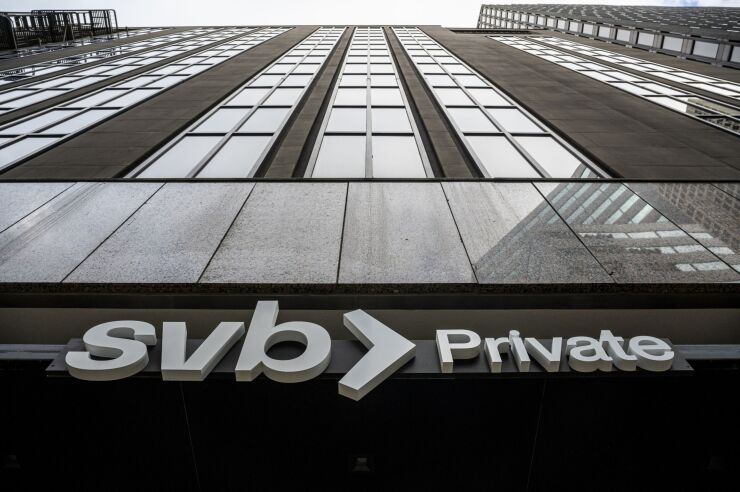
WASHINGTON — The Government Accountability Office,
The Fed has, so far, taken the brunt of criticism regarding the failure of Silicon Valley Bank, particularly from congressional Republicans. In the immediate aftermath of the bank failures, Rep. Patrick McHenry, R-N.C., and the panel's ranking member Rep. Maxine Waters, D-Calif.,
In its report, the GAO found that the San Francisco Fed — the regional Fed bank that supervised Silicon Valley Bank — fell short of following up on concerns that examiners identified at the bank. Examiners flagged problems at the bank as early as 2018, according to the report.
At that time, the San Francisco Fed found that despite liquidity levels appearing strong, Silicon Valley Bank's funding sources were concentrated and could be volatile. The regulator issued, or had outstanding matters requiring attention related to risk management and liquidity, in 2018, 2018 and 2022, the report said.
The San Francisco Fed downgraded Silicon Valley Bank's composite capital adequacy, assets, management capability, earnings, liquidity and sensitivity rating (its CAMELS score), in 2022 from
"Specifically, FRBSF examiners found that the bank's management and board performance needed improvement and were less than satisfactory," according to the report. "For example, the board did not provide effective oversight of implementation of the risk-management framework and execution of the bank's transition into the Large Financial Institution category. The board also did not hold management accountable for the root causes contributing to weaknesses in liquidity risk management and other risks."
A supervisory letter in 2022 shows that the San Francisco Fed stated its intent to initiate an informal, nonpublic enforcement action in the form of a memorandum of understanding, related to correcting the management and liquidity risks mentioned in the CAMELS downgrade. The Fed staff began working with the Fed Board's Supervision and Regulation Legal divisions in late August, and that memorandum was kept open to allow additional examination work by the San Francisco Fed.
"However, the Federal Reserve did not finalize it before SVB failed in March 2023," the GAO said in the report.
Overall, the GAO found that the San Francisco Fed staff "generally accepted SVB's planned actions to correct deficiencies."
"Our review of examination staff's acknowledgement of SVB management responses found the staff generally agreed that SVB's planned actions were reasonably designed to remediate the underlying supervisory issues," GAO said in the report. "FRBSF staff also said that SVB generally was taking actions to address risks associated with the 2023 failure, but the remediation process was time-consuming considering the scope of the issues."
For example, in May 2022, the San Francisco Fed granted Silicon Valley Bank a seven-month extension to address a matter from November 2021 that required immediate attention.

"Although Federal Reserve staff stated that the Federal Reserve's supervisory actions compelled SVB to take steps including replacing the Board Chair, Chief Risk Officer, and Treasurer and revising its incentive compensation program to incorporate risk management as a formal assessment criteria, its supervisory actions were inadequate given the bank's known liquidity and management deficiencies," according to the report. "Furthermore, FRBSF's actions lacked urgency."
The San Francisco Fed did not, for instance, recommend the issuance of a single enforcement action despite the bank's "serious liquidity and management issues," before it failed.
The GAO said it plans to continue to examine the Fed and the San Francisco Fed's decision making process in an upcoming review.
The oversight body found more robust supervision at the Federal Deposit Insurance Corp.'s oversight of Signature Bank, the second bank to fail last month.
"FDIC took numerous supervisory actions to mitigate liquidity and management deficiencies at the bank, including downgrading Signature Bank's liquidity component from a 2 to a 3 during the 2019 examination cycle," according to the report.
The FDIC also issued matters requiring board attention and supervisory recommendations related to management, liquidity and corporate governance risks in each year before the bank's failure, the GAO said in the report.
"In addition to the matters and supervisory recommendations FDIC issued in a given year, many matters and recommendations carried over to later years because they were unresolved," the GAO said. "For instance, FDIC's 2019 matter to Signature Bank on liquidity contingency planning remained outstanding through the bank's failure in March 2023."
The GAO report also sheds some light on regulators' decision to implement a systemic risk exception, which allowed the FDIC to guarantee all uninsured deposits at the two failed banks.
Central to that discussion was the fact that many of the uninsured deposits at the two banks were corporate enterprises, therefore losses to these firms could put them at risk of not being able to make payroll and pay suppliers.
"In addition, several payroll companies contracted with SVB to process paychecks, which led to delayed payroll for companies that did not bank at SVB," according to the report. "The Federal Reserve also reported that some companies that held deposits at SVB were forced to sell their uninsured deposit claims at 90 cents on the dollar on March 10, 2023, to make payroll."
Some of the agency staff had raised concerns about exacerbating moral hazard, and weakening the market discipline of many depository institutions, the GAO said. That will also be the subject of an upcoming GAO report.





